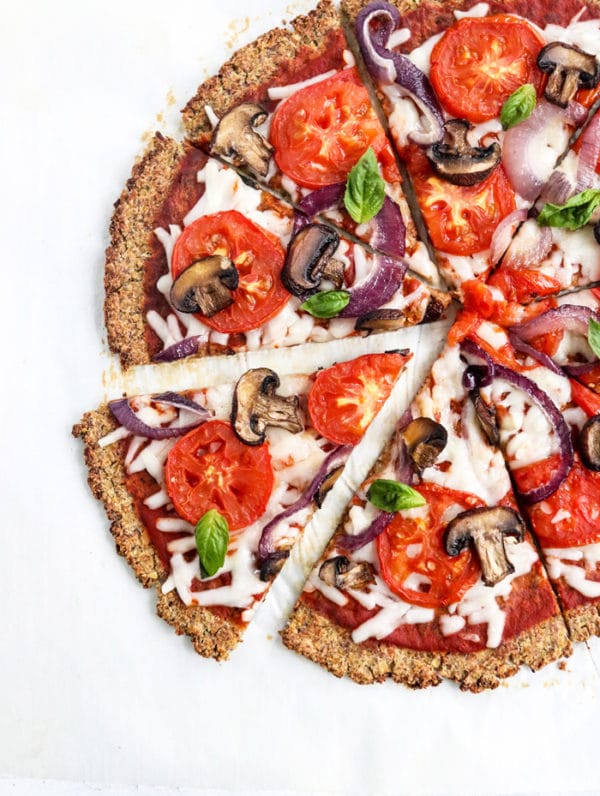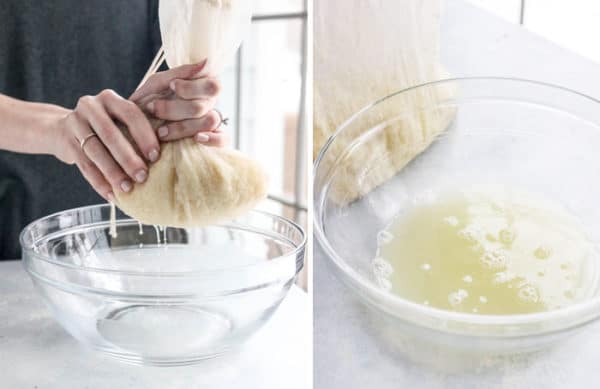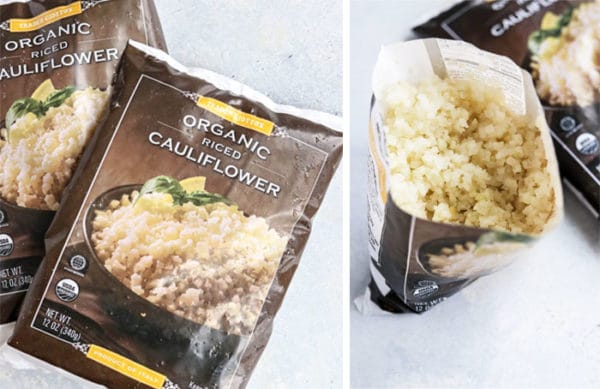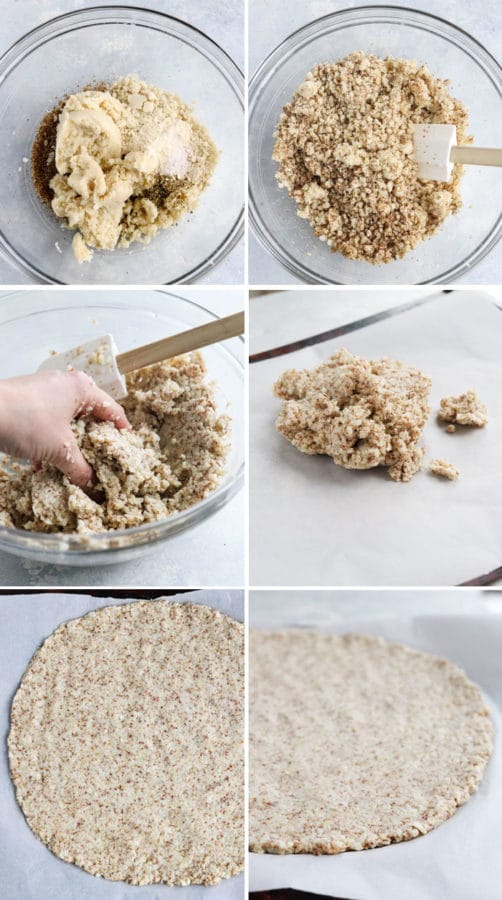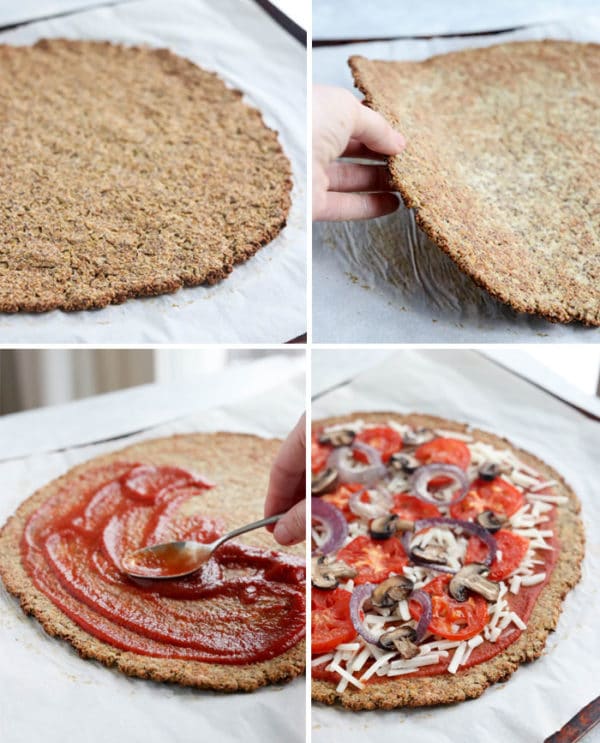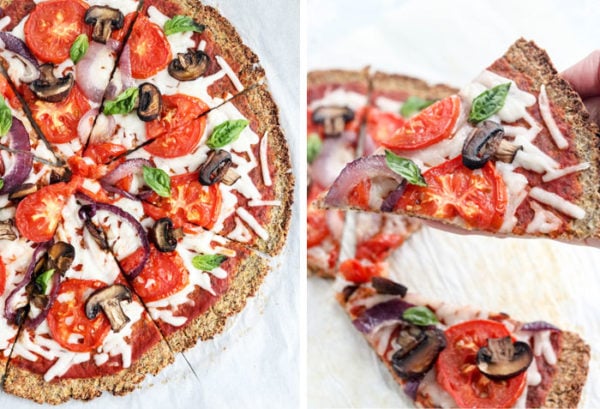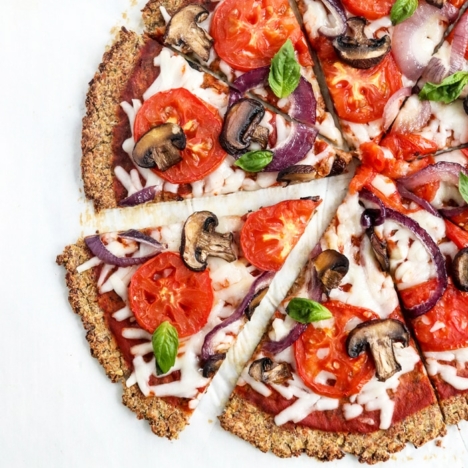Unlike my original cauliflower pizza crust, this recipe uses ground flax as a binder instead of eggs. Flax eggs are made by simply stirring together freshly ground seeds and water to make a gluey, egg-like replacement, but since cauliflower is already loaded with so much moisture, we’re using much less water in this recipe to account for that. This gives you a drier pizza crust that you can hold with your hands.
How to Make Vegan Cauliflower Pizza Crust
This crust is made with just a handful of all-natural ingredients. All you need is some cauliflower (bonus if it’s already “riced” for you), ground flax, almond flour, and seasonings. The key to getting a dry vegan cauliflower pizza crust that you can hold with your hands is to wring-out all of the moisture first.
To do this, you’ll need to cook the cauliflower first. You can steam it or dry roast it, if you’re using fresh cauliflower.
Frozen Cauliflower Rice for an EASY Vegan Pizza Crust
Alternatively, you can buy frozen cauliflower and let it thaw in your fridge overnight. This is my preferred method, because there’s no extra cooking involved. If you use frozen florets, you’ll need to process them in a food processor (affiliate link) first, but many stores are starting to carry frozen cauliflower rice, which makes this recipe even easier!
If you can find frozen cauliflower rice, simply thaw it in the fridge the night before (or you can heat it up if you’re in a hurry), then transfer it to a towel or nut milk bag (affiliate link) and squeeze it until you can’t get any more liquid out. I usually end up with at least 1/2 cup of liquid squeezed out, so it should be a significant amount to get a very dry cauliflower pizza crust.
Vegan Cauliflower Pizza Dough
Once you have the dry cauliflower “pulp,” add it to the ground flax, almond flour, and seasonings. It may look crumbly at first, but I find that if you mix it with your hands (or an electric hand/stand mixer) it starts to stick together nicely.
Keep in mind that this is not your average pizza dough. It won’t be stretchy, because there’s no gluten involved. Instead, it will be a pile that you’ll need to press out onto a large pizza sheet. Get your hands wet if the pizza “dough” sticks to them too much, as that will help you press it out. You want the pizza to be a flat and even as possible. The flatter it gets, the drier the resulting crust will be. I can get this crust to be about 12-14 inches in diameter, or you can make two 6-8 inch pizzas if you prefer something smaller to work with. (It’s easier to flip if they are smaller!)
Bake the pizza crust until it is dry and easy to pick up with your hands, about 45 minutes. You can flip it over at this point and bake for 10-15 minutes more to dry out the other side, but I’m usually impatient and just start adding the toppings after I flip it over. (Tip: Use the parchment paper to help you flip over the large crust. I keep one hand on the crust itself, and pick up the parchment with my other hand to sandwich the crust and keep it from breaking.) Since this process is still a bit labor-intensive, I recommend making a double batch so you can keep an extra crust in the freezer for an easy pizza night in the future.
Recipe Notes:
If you freeze the plain crust, you can top it straight from the freezer and bake for 10-15 minutes at 350ºF for a fast pizza night. For an even easier “vegan pizza,” try making my Eggplant Pizzas, Cauliflower Steak Pizza, or Zucchini Boat Pizzas using the vegan toppings that you love.
— Reader Feedback: Have you tried the cauliflower pizza crust yet? Whether it’s the original recipe or this vegan version, I hope you enjoy this gluten-free alternative! SaveSave SaveSave SaveSave

